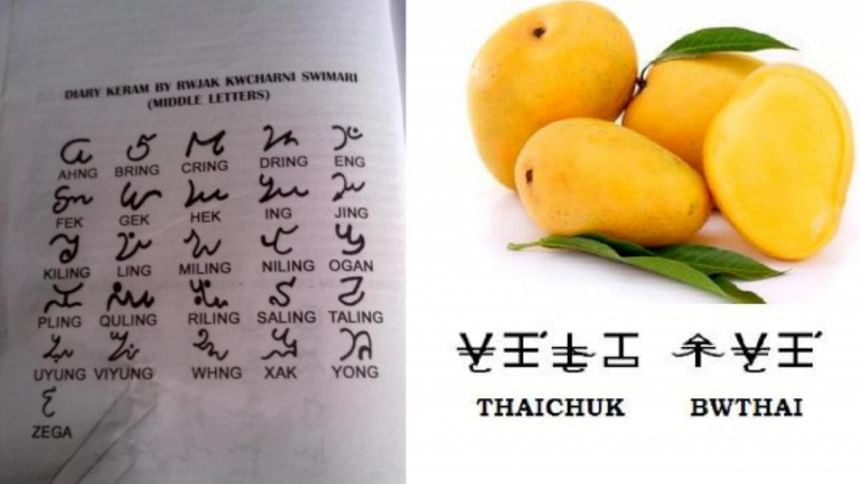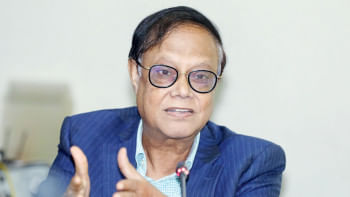The Magic of Scripts

While growing up in a Tripura community of Khagrachhari in the Chittagong Hill Tracts, an ethnically diverse and geographically distinct region of Bangladesh, I became familiar with a myth that explained why the Tripuras did not have a script or writing system of their own. According to this myth, once upon a time, the Tripuras did have their own alphabet, the letters of which were written on the leaves of a plant. Unfortunately, one day those precious leaves were eaten up by a goat, thus the Tripuras lost their script for ever. To date, when goats are sacrificed during different rituals, Tripuras with a flair for the occult talk about how the lost letters can be discerned vaguely on the entrails of the slaughtered animals.
It turns out that myths of lost scripts are not unique to the Tripuras, but are found in different forms among many other ethnic groups in Bangladesh and beyond. For example, the Mros—a people indigenous to the Bandarban hill district of Bangladesh and some areas of Myanmar—too have a similar myth. In their case, the mythical scapegoat is a gayal, a bovine that had been tasked by the supreme god Turai to deliver the script and scriptures meant for the Mro people, but it ate up its payload on the way, thus depriving the Mros of a holy book of their own. Similarly, the Garos or Mandis have a myth that says that their ancestors lost their script during a long journey through a mountainous region as they got very hungry and ended up boiling and eating the animal skins on which the script had been written.
I used to think (as I indicated in a Bangla article of mine published in 2000) that myths of the above kinds could be interpreted as justification by non-literate cultures as to their distinctiveness vis-à-vis literate civilisations. However, more recently, I came across a more radical explanation of such stories as offered by the anthropologist James Scott. In his book The Art of Not Being Governed: An Anarchist History of Upland Southeast Asia, first published in 2010, Scott suggests that the kinds of stories under consideration may be treated as legends that "embody a germ of historical truth" relating to societies that in many cases may be better conceptualised as having been post-literate as opposed to preliterate. In other words, the societies concerned may have abandoned, or deliberately avoided, literacy along with state organisation and intensive agriculture to pursue an alternative mode of being.
In this article, however, I do not seek to dwell on or add to the perspective suggested by Scott. Instead, I would like to bring up a much older anthropological notion that equated literacy with cultural advancement, and examine how similar notions continue to inform dominant views about the languages of the indigenous peoples of Bangladesh. The old anthropological notion that I have in mind has to do with the fact that in 19th-century anthropology, and in Western social thought of that time more generally, literacy and the use of writing systems were widely viewed as important measures of the evolutionary heights achieved by different cultures or civilisations. The most "civilised" societies were assumed to be those that possessed alphabets, particularly of phonetic varieties, whereas cultures lacking any form of writing system were thought of as "primitive" (e.g. see Edward Burnett Tylor's Primitive Culture, and Lewis Henry Morgan's Ancient Society, published in 1871 and 1877 respectively).

Although the label "primitive" would soon become unfashionable as well as conceptually untenable within anthropology, it was simply replaced by categories like non-literate or preliterate that continued to reproduce, albeit in a less recognisable form, the same types of evolutionist notions and pejorative connotations that dichotomies such as "civilised vs primitive" carried with them. For example, the very term "preliterate" betrays a hidden assumption that literacy is an inevitable direction to which all societies have to move inexorably.
Given the cultural pride stemming from the idea of an ethnic group having its own script, in case of groups that do not possess their "own" scripts, there have been repeated attempts by many individuals to invent new ones. For example, as of 2000, I personally knew of three Bangladeshi Tripuras who had invented scripts for Kokborok independently. And more recently, I came across—on Facebook—two new scripts for Kokborok as invented by individuals in Tripura, India. Similarly, five Bangladeshi Garos are reported to have invented separate scripts for their language. Such attempts are actually quite common throughout South Asia and beyond, as indicated by a story headlined "Writing a new identity: Indigenous tribes across India devising scripts," published in The Times of India on June 7, 2015.
While most invented scripts fail to generate sufficient support for them to be considered seriously, there are a few notable exceptions. In Bangladesh, one such exception occurred among the Mro people, whose script and scriptures had been eaten up by a mythical gayal, as indicated already. In a significant development, in the mid-1980s, a messianic figure by the name of Menlay arose from among the Mros, who were among the ethnic groups that had remained most resistant to external cultural influences.
From the perspective of outsiders, until recently, one sign of the Mros remaining less acculturated was their semi-nude bodies, along with the men keeping their hair long, very low rates of literacy and heavy dependence on jum (shifting) cultivation. In this context, Menlay emerged as a messianic leader who not only invented a script for his people, but also came up with a religion, complete with its own written codes, which came to be known as Krama. This new religion—which prescribed, among other things, a new dress code and hairstyle that would make converts look less exotic or "primitive"—gained considerable following very quickly among the Mros (and even among many Khumis, a different ethnic group, members of which live closely with the Mros) in Bangladesh as well as across the border in Myanmar. Followers of the new religion were also expected to learn the new script, which began to be used in writing down codes of the Krama religion.
It so happens that there are also adherents of other religions—including traditional "animism", Buddhism and Christianity—among the Mros. In case of Mros who converted to Christianity, some got used to using their language in written form in a limited way using the Roman script. However, with the spread of Krama, the newly devised Mro script caught on and was also quickly picked up by NGOs and other organisations that provided material support to promote its use at various levels including in schools at pre-primary and primary levels. It is estimated that around 60 percent of Mros of Bangladesh are literate in their language (this figure probably includes individuals who learned the use of the script not from attending schools, but as part of taking part in Krama rituals). However, on the whole, official literacy rates among the Mros—measured in terms of formal schooling—still remain one of the lowest among all ethnic groups of the Chittagong Hill Tracts.
There are some indications that for a long period in the past (say, over 50 years ago), the Mros used to be fairly contented and accustomed to a self-sufficient way of life. However, in the context of the recent history of the Chittagong Hill Tracts, the Mros have suffered immensely in various ways. For example, they were armed and pitted against PCJSS, a regional political party that waged an armed campaign since the 1970s until the "peace" accord of 1997, demanding regional autonomy for the indigenous peoples of the CHT region. It was in the context of such a violent background that the Mro script emerged.
Menlay was among the first cohort of students attending a boarding school built exclusively for Mro children by military-backed regimes that ruled Bangladesh from 1975 to 1990. Menlay must have been an unusual student in the boarding school (launched around 1980) as he is said to have been 18 when he enrolled as a first grader! The school was managed by teachers and administrators who were members of dominant ethnic groups that never tried to learn the Mro language. Reportedly, they were reluctant to take Menlay in, but relented at his persistence (he camped out on the school compound where he had gone on a fast). However, by around 1984, he lost interest in school as well as in worldly affairs, and went away on a quest that would lead to the Krama script and religion by 1985. Within a year and a half of his dramatic revelation of the Krama script and religion, he "disappeared", not to be seen or heard from again so far, though his followers believe that he will return one day.
Now the Mros have their script alright, but their lands continue to be grabbed by powerful interest groups of all kinds. They also continue to face increasing levels of poverty and violence, and there is an indication that some of them reorganised into armed groups within the past decade under names like Mro National Party. In this connection, it may be mentioned that Menrum Mro, a well-known educated person who had developed computer fonts called "Riyen" for the Krama alphabet in 1996, is believed to have been a founder of one such group, but he is reported to have been killed sometime in 2012 or 2013 under circumstances that this author has not been able to find out any definite or reliable information on. If the above information about him is true, we need to ask: what are the circumstances that would drive a computer-savvy, educated Mro to take up arms?
Seen in a broader context, the story of the rise of the Mro (Krama) script is a remarkable one which has many layers that need to be examined far more deeply and thoroughly than what we can achieve in this article. There are many more questions that remain to be asked and answered. In Bangladesh, the Mros are a minority among minorities, and as yet have very low literacy rates by formal standards. Yet in a remarkable development, almost in no time they can boast of a script of their own that has a Unicode version under development. What do we make of this? Will Menlay, who disappeared after leaving behind the "Mro script", ever return as the messiah that his followers believe him to be? Will the Mros be able to hold onto their remaining ancestral lands and their traditional livelihoods against all odds? Or does the tragic fate of Menrum Mro signal a realisation on the part of some Mros that the Krama script and religion are not the magic bullets that can protect them from the onslaught of external forces (represented and/or facilitated by the state, market and development organisations of all kinds)?
Prashanta Tripura is an academic anthropologist turned development professional.
An earlier version of this article (based on excerpts from a paper titled "Scripting Minority Identities: Nationalism and Linguistic Diversity in Bangladesh" as presented at an international seminar held in October 2015, at the University of Hyderabad) has been published on the author's personal blog named Neolithic Musings.

 For all latest news, follow The Daily Star's Google News channel.
For all latest news, follow The Daily Star's Google News channel. 



Comments